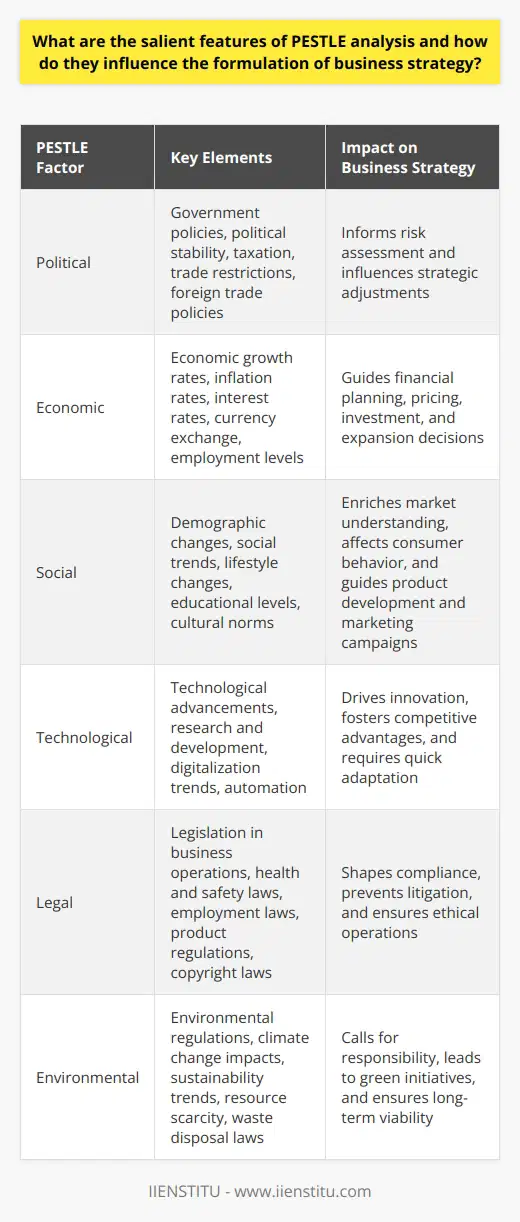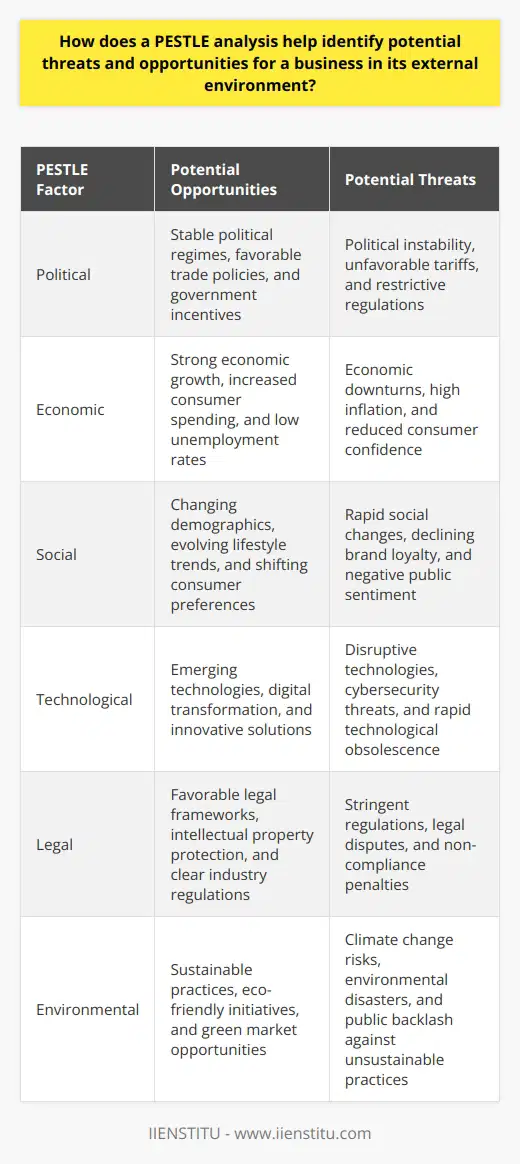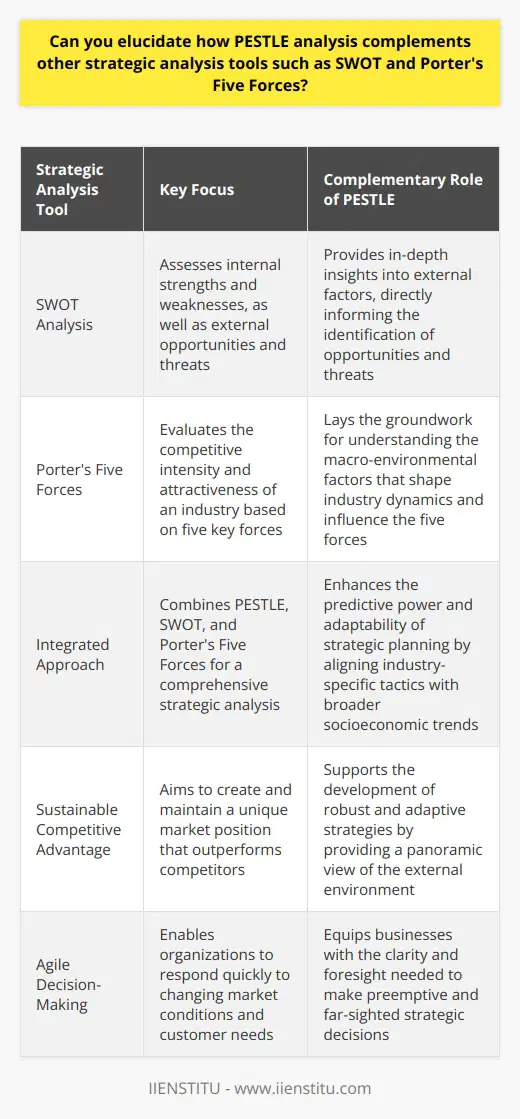
In the dynamic world of business, strategy consultants and company leaders seek out robust frameworks to navigate complex environments. PESTLE Analysis stands as a beacon, providing comprehensive insights into the macro-environmental factors that might impact an entity's trajectory. This investigative tool delves into Political, Economic, Sociocultural, Technological, Legal, and Environmental facets, delivering a prism through which organizations can forecast risks and discover opportunities.
It is incumbent upon modern businesses to incorporate PESTLE Analysis into their strategic planning to remain agile and informed within an increasingly intricate global marketplace.
Understanding PESTLE Analysis
Political Factors
Political factors play a pivotal role in shaping the environment in which businesses operate. This aspect of the PESTLE Analysis involves evaluating the stability of the political environment, the presence of any trade embargos or sanctions, tax policies, employment laws, and other political decisions that could influence business operations.
For instance, a change in government can lead to significant shifts in fiscal policy and regulatory guidelines, impacting investment appeal and market accessibility. Businesses leveraged in international trade must stay acutely aware of geopolitical shifts that could alter trade agreements or introduce new barriers.
Economic Factors
The economic environment can greatly affect a company's ability to thrive and expand. The elements scrutinized within this category include economic growth or recession trends, inflation rates, interest rates, exchange rates, and overall economic stability. A business needs to anticipate economic downturns to mitigate adverse impacts on revenue and profits.
Awareness of these factors facilitates foresight in international dealings, given that fluctuations in currency can alter importing and exporting margins, thus influencing pricing strategies and market competitiveness.
Sociocultural Factors
Sociocultural factors are quintessential in understanding customer behavior, preferences, and potential markets for new ventures. This involves analyzing demographic shifts, lifestyle changes, educational levels, cultural norms, and changes in social trends. A pertinent example would be the increasing concern for healthy living, which has realigned the food industry towards offering healthier product alternatives.
Companies that continuously monitor sociocultural trends can tailor their operations and marketing strategies to resonate with the evolving desires of the consumer base.
Technological Factors
Modern businesses cannot afford to overlook the swift pace of technological advancement. The analysis of technological factors includes the consideration of innovation, automation, research and development activity, and the rate of technological obsolescence. Organizations that invest in emerging technologies can drive down costs, enhance product offerings, and outpace competitors. Additionally, the cybersecurity landscape and data protection regulations are also a crucial consideration under technological factors, especially for companies that handle significant amounts of customer data.
Legal Factors
Legal factors encompass laws on company formation, health and safety guidelines, consumer rights, and industry-specific regulations. Meeting these legal requirements is not merely a matter of compliance but also a strategic consideration. For example, data protection laws affect how companies collect and utilize consumer data, thereby influencing marketing strategies and customer engagement practices.
Environmental Factors
Environmental considerations have ascended in prominence, encapsulated in aspects such as climate change policies, waste disposal laws, and the sustainability of resources. The heightened awareness of environmental impact, coupled with stricter regulations, compels companies to adopt sustainable practices and consider ecological implications in their long-term planning.
The Process of Conducting a PESTLE Analysis
Identifying pertinent factors in each PESTLE category is the initial step in conducting the analysis. This requires a comprehensive understanding of the business context and the ability to discern which external factors are most relevant to the firm's situation. Experts often leverage a multitude of information sources ranging from news articles and industry reports to market analysis to assemble the required data.
In the collection and evaluation phase, the information gathered must be systematically analyzed to ensure objective interpretation. The relevance and potential impact of each factor are assessed, allowing organizations to prioritize areas of concern and opportunities. This stage also involves looking for correlations and intersections between different PESTLE components, which can compound the effects on the business.
Finally, interpretation and implementation are critical. This entails synthesizing the extensive information into actionable insights that can be integrated into strategic business planning. Formulating strategies that capitalize on identified opportunities while mitigating identified risks ensures the application of PESTLE Analysis translates into tangible benefits for the organization.
Benefits of Using PESTLE Analysis
PESTLE Analysis facilitates an improved decision-making process by providing a structured overview of the external environmental factors that could impact the organization. This thorough examination enables businesses to predict changes and prepare accordingly, reducing the probability of adverse surprises that can derail strategic initiatives.
Identification of potential opportunities and threats is another advantage offered by PESTLE Analysis. By situating the company within the broader external context, it allows for the recognition of untapped markets, potential collaborations, or developments that could affect product demand.
A better understanding of uncontrollable external forces propels businesses towards resilience. Navigating through these forces with a proactive mindset allows organizations to position themselves advantageously relative to competitors who might take a more reactive approach.
Furthermore, PESTLE Analysis fosters proactive thinking and strategic planning, prompting organizations to look beyond immediate concerns and consider long-term implications of external factors on their operations and strategic goals.
Limitations of PESTLE Analysis
Conducting a comprehensive PESTLE Analysis demands significant time and effort due to the vast array of factors to be considered and the depth of research required. The potential for substantial returns on this investment exists; however, some entities may be dissuaded by this initial barrier, thereby forgoing the potential insights PESTLE Analysis could yield.
An inherent potential bias and inaccuracy in data collection cannot be overlooked. The subjective nature of interpreting political, sociocultural, and even environmental factors can sway the outcomes of the analysis, leading to skewed strategic decisions if not handled with rigor and objectivity.
The utility of PESTLE Analysis is occasionally challenged by the rapidly changing external environment. Implications drawn from the analysis may become obsolete if external conditions shift suddenly, rendering the analysis an imprecise tool for long-term planning.
PESTLE Analysis in Practice: Case Studies
Businesses across sectors have employed PESTLE Analysis to navigate through uncertain environments successfully. Case studies illustrate how organizations have harnessed insights from this analysis to make pivotal adjustments to their business strategies, resulting in enhanced adaptation to external pressures.
The impact of PESTLE Analysis on business strategy and performance becomes evident when observing these case studies in detail. They demonstrate the transformational power that comprehensive external analysis can wield when correctly interpreted and implemented into business strategy.
In conclusion, PESTLE Analysis emerges as an invaluable tool for businesses seeking to align their strategies with the fluctuating tapestry of external influences. Its application reinforces the capacity for informed decision-making and cultivates a strategic approach that is sensitive to the wider socio-economic and political environment. As entities globally grapple with rapidly evolving landscapes, the continued and consistent use of PESTLE Analysis in strategic planning and risk management proves instrumental in fortifying businesses against the unpredictable nature of external factors.
Frequently Asked Questions
What are the salient features of PESTLE analysis and how do they influence the formulation of business strategy?
Understanding PESTLE Analysis
PESTLE analysis stands for Political, Economic, Social, Technological, Legal, and Environmental analysis. It is a strategic framework. Analysts and strategists use it to examine external factors. These factors impact businesses and industries.
Political Factors
Political features shape strategy. They include government policies and political stability. Taxation changes play a role too. Political factors also involve trade restrictions. Foreign trade policies are significant. Political factors inform risk assessment. Businesses adjust strategies accordingly.
Economic Factors
Economic features guide financial planning. They encompass economic growth rates. Inflation rates and interest rates matter. Currency exchange is essential. Employment levels require consideration. Economic indicators influence decision-making. They affect supply and demand. Pricing, investment, and expansion plans hinge on them.
Social Factors
Social features enrich market understanding. They encapsulate demographic changes. Social trends are key. Lifestyle changes inform strategies. Educational levels are important. Social factors affect consumer behavior. Cultural norms guide product development. Marketing campaigns must align with them.
Technological Factors
Technological features drive innovation. They cover technological advancements. Research and development activities are central. Digitalization trends are important. Automation influences operational strategies. Information technology changes fast. Companies must adapt quickly. They foster competitive advantages.
Legal Factors
Legal features shape compliance. They involve legislation in business operations. Health and safety laws are crucial. Employment laws dictate HR strategies. Product regulations ensure safety. Copyright laws protect intellectual property. Legal considerations prevent litigation. They ensure ethical operations.
Environmental Factors
Environmental features call for responsibility. They include environmental regulations. Climate change impacts strategies. Sustainability trends are pivotal. Resource scarcity requires action. Waste disposal laws matter. Environmental factors lead to green initiatives. They ensure long-term viability.
Influence on Business Strategy
PESTLE analysis shapes business strategy formulation. It ensures comprehensive market understanding. Organizations align strategies with external factors. They mitigate risks through informed decisions. Competitive advantage emerges from this approach.
Companies identify growth opportunities. They optimize operations in response. Strategic alignments increase profitability. They also ensure sustainability.
Adapting to changing circumstances is essential. PESTLE analysis provides this adaptability. Continuous monitoring is crucial. It enables proactive versus reactive strategy.
Strategists view the macro environment holistically. They make strategic choices with confidence. External factors are unpredictable. However, PESTLE analysis manages this unpredictability. It fosters resilience and agility in businesses. These features translate to strategic success in dynamic markets.

How does a PESTLE analysis help identify potential threats and opportunities for a business in its external environment?
Understanding PESTLE Analysis
PESTLE stands for Political, Economic, Social, Technological, Legal, and Environmental. It is a strategic tool. Companies use it to track the environment they operate in. This analysis spots changes or trends. The goal? To identify potential opportunities and threats.
Political Analysis
The political aspect examines government policies. These influence business operations. Chronic instability can be a threat. Conversely, stable regimes can mean opportunity. Firms understand how political shifts can affect their business. Tariffs, trade deals, or fiscal policy can make or break markets.
Economic Analysis
Economists look at market trends. They consider unemployment, inflation, and growth rates. Businesses track these factors. They adapt to changing economic landscapes. A strong economy signals opportunity. It spurs consumer spending. A weak economy is a threat. It pressures profits.
Social Analysis
Social trends impact demand for products. Companies study demographics. They look at lifestyle changes. This knowledge is pivotal. It helps businesses tailor products to shifting consumer needs. Aging populations imply different opportunities than young, growing ones. Social change can redefine markets entirely.
Technological Analysis
Technology evolves rapidly. It disrupts industries. Companies that adapt can thrive. Those that don't may struggle. Firms leverage new technologies for competitive edge. They watch for advancements. They aim to adopt them before competitors do. Ignoring tech trends is a significant threat.
Legal Analysis
The legal landscape shapes business boundaries. Law changes dictate compliance demands. Companies must conform to new regulations. Non-compliance is a threat. It can lead to fines or reputation damage. Keeping abreast of legislation changes is critical. It safeguards against legal pitfalls.
Environmental Analysis
Awareness of environmental factors is essential. Climate change and sustainability are central. Public sentiment pushes towards green practices. Companies that embrace this shift can capture new markets. Ignoring environmental concerns poses risks. It can alienate customers and invite backlash.
PESTLE Analysis Benefits
A PESTLE analysis helps firms navigate complex environments. It provides a comprehensive view of the external landscape. Organizations can spot early signs of opportunities and threats. By being proactive, firms can devise strategies to capitalize on trends or mitigate risks. This vigilance is necessary for sustained success.
In conclusion, PESTLE analysis is a vital strategic tool. It ensures that businesses stay ahead of external factors. Those that conduct regular PESTLE analyses are better positioned. They handle the rapidly evolving world of business. They are ready both to seize opportunities and counteract potential threats.

Can you elucidate how PESTLE analysis complements other strategic analysis tools such as SWOT and Porter's Five Forces?
PESTLE Analysis Complements Strategic Tools
Strategic analysis tools guide businesses through complex environments. To thrive, companies need a detailed roadmap. PESTLE analysis is one such tool. It expands the horizon of strategic planning. PESTLE stands for Political, Economic, Social, Technological, Legal, and Environmental factors. It reviews external macro-environmental factors. These affect an organization's performance. Now, let's discuss how PESTLE analysis complements SWOT and Porter's Five Forces.
PESTLE and SWOT: A Synergistic Approach
SWOT stands for Strengths, Weaknesses, Opportunities, and Threats. It dissects internal and external factors. The internal factors are strengths and weaknesses. The external are opportunities and threats. PESTLE inputs are crucial here. They provide in-depth insights into opportunities and threats.
Imagine PESTLE as the backdrop for SWOT. It uncovers external conditions. These conditions inform the 'OT' in SWOT. Thus, PESTLE directly affects strategic planning. It unveils regulatory risks or technological shifts. Companies can use this to craft robust opportunities. They can foresee possible threats. Obviously, this information shapes internal strategic decisions.
Together, SWOT and PESTLE offer a comprehensive picture. They help firms assess their internal capabilities. They also assess their response to external changes.
Enhancing Porter's Five Forces with PESTLE
Porter's Five Forces model focuses on industry structure. It evaluates competitive intensity and attractiveness. The five forces are as follows:
- Threat of new entrants
- Bargaining power of suppliers
- Bargaining power of customers
- Threat of substitutes
- Competitive rivalry
Each force is vital. But, understanding the macro environment is crucial too. That's where PESTLE adds value. It lays the groundwork for Porter's analysis. Political factors can shape new entrant threats. Economic shifts can alter the bargaining power dynamics. Social trends can fuel the threat of substitutes. Technological advancements can spike competitive rivalry. Legal changes can upend the whole industry structure.
Using PESTLE, firms grasp the "bigger picture". They don't just look at the industry. They consider the world around the industry. It's easy to see how this complements Porter's insights. Companies get a multi-dimensional view. They align industry-specific tactics with broader socioeconomic trends.
Integrated Strategy Development
In essence, PESTLE serves a foundational role. It provides the context for SWOT and Porter's Five Forces. It enhances their predictive power. It deepens strategic analysis. Here's how the integration can occur:
- Use PESTLE to scan the environment.
- Apply SWOT to align external factors with internal capabilities.
- Deploy Porter's Five Forces to navigate the industry terrain.
Strategic planning can't exist in a vacuum. Combining PESTLE with SWOT and Porter's ensures that. Businesses operate with clarity. They craft strategies that are not only robust but also adaptive. They become agile, preemptive, and far-sighted.
In conclusion, PESTLE complements and enriches SWOT and Porter’s Five Forces. It turns a narrow view into a panoramic strategic outlook. This combination supports sustainable competitive advantage. Firms should embrace this integrated approach. Success in today's complex environment demands it.



